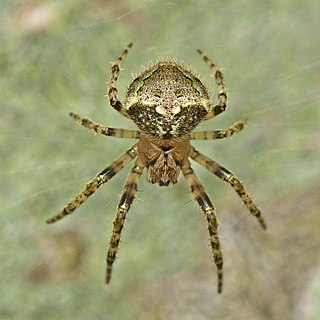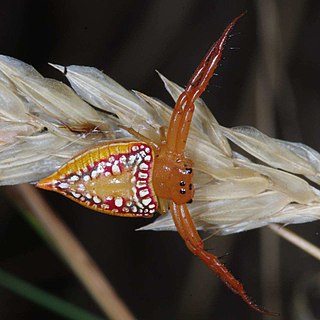
Orb-weaver spiders are members of the spider family Araneidae. They are the most common group of builders of spiral wheel-shaped webs often found in gardens, fields, and forests. The English word "orb" can mean "circular", hence the English name of the group. Araneids have eight similar eyes, hairy or spiny legs, and no stridulating organs.

Gasteracantha is a genus of orb-weaver spiders first named by Carl Jakob Sundevall in 1833. Species of the genus are known as spiny-backed orb-weavers, spiny orb-weavers, or spiny spiders. The females of most species are brightly colored with six prominent spines on their broad, hardened, shell-like abdomens. The name Gasteracantha is derived from the Greek gaster (γαστήρ), meaning "belly, abdomen", and akantha (άκανθα), meaning "thorn, spine". Spiny-backed orb-weavers are sometimes colloquially called "crab spiders" because of their shape, but they are not closely related to the true crab spiders. Other colloquial names for certain species include thorn spider, star spider, kite spider, or jewel spider.

Ordgarius is a genus of orb-weaver spiders first described by Eugen von Keyserling in 1886. Adult females of the genus are bolas spiders, capturing their prey with one or more sticky drops at the end of a single line of silk rather than in a web. Males and juvenile females capture their prey directly with their legs.

Arkys, also known as triangular spider or ambush spider, is a genus of Australian araneomorph spiders in the family Arkyidae, first described by Charles Athanase Walckenaer in 1837. They are often small, with a triangular shaped abdomen, and are found in Australia and some of its surrounding islands. They don't build webs, but can often be found on leaves and tips of flower heads. Their egg sacs are pinkish-orange and spherical, and are made late in the summer.

Missulena insignis, commonly known as the lesser red-headed mouse spider, is a species of spider belonging to the family Actinopodidae native to Australia. The species name is derived from the Latin insignis "mark".

The spider species Plebs eburnus is commonly referred to as the eastern grass orb-weaver or the eastern bush orb-weaver, and sometimes more simply as the bush orb-weaver. It is an orb-weaver spider from the family Araneidae endemic to Australia. It is a very common spider with distinctive white markings, which give it the species name eburnus pertaining to ivory. It is found in scrub and tall grasses where the female constructs a vertical web usually no more than 2 metres from the ground, and stays there day and night. The web of some of these spiders has been seen to be decorated with nearly vertical stabilimentum. The stabilimentum of the related P.cyphoxis is usually observed vertical.

Plebs is a genus of orb-weaver spiders first described by M. M. Joseph & V. W. Framenau in 2012. Though many of its species have been moved around, a 2012 taxonomic revision suggested that these spiders comprise a monophyletic genus of closely related spiders that evolved in Australia and, through subsequent movements, spread into parts of Asia and Pacific islands.

Arkyidae, also known as triangular spiders, is a family of araneomorph spiders first described by Ludwig Carl Christian Koch in 1872 as a subfamily of Araneidae, and later elevated to a full family in 2017.

Backobourkia is a genus of South Pacific orb-weaver spiders first described by Volker Framenau, Nadine Dupérré, Todd Blackledge & Cor Vink in 2010. It is a common Australian spider, closely related to Eriophora and placed in the "coxal hook clade" of the Araneinae subfamily of Araneidae. Females are generally the same size among all species, but males are much smaller, suggesting male dwarfism throughout the genus. The genus name is a play on the well-known Australian idiom, "Back of Bourke", meaning very remote and beyond the limits of civilization.
Carepalxis is a genus of orb-weaver spiders first described by Ludwig Carl Christian Koch in 1872. These spiders only build webs at night and break them down in the morning. C. coronata builds orb webs up to 60 centimetres (24 in) in diameter with closely woven spiral threads.
Cyrtobill is a genus of Australian orb-weaver spiders containing the single species, Cyrtobill darwini. It was first described by V. W. Framenau & N. Scharff in 2009, and has only been found in Australia.

Demadiana is a genus of Australian araneomorph spiders in the family Arkyidae, first described by Embrik Strand in 1929.
Heurodes was a genus of orb-weaver spiders first described by Eugen von Keyserling in 1886. It previously contained three species, Heurodes fratrellus and Heurodes turritus, both now considered nomen dubium, and Heurodes porcula, now considered a synonym of Eriovixia porcula(Simon, 1877)
Taczanowskia is a genus of orb-weaver spiders first described by Eugen von Keyserling in 1879. Contrary to the common name of the group, spiders of the genus Taczanowskia do not build webs and are furtive hunters, deceiving their prey by producing sex pheromones that attract male moths, and catching their prey by using a pair of enlarged claws at the tip of their anterior legs.

Telaprocera is a genus of Australian orb-weaver spiders first described by A. M. T. Harmer & V. W. Framenau in 2008. As of April 2019 it contains only two species.
Collina glabicira is a species of Tasmanian orb-weaver spiders first described by A. T. Urquhart in 1891, and the only species in the genus Collina. It is known from a single female holotype that is not among the types at the Canterbury Museum, nor was a plate of the figure ever printed. The original description alone is not enough to identify it, so this species and its genus are considered nomina dubia.
Lariniophora is a genus of orb-weaver spiders containing the single species, Lariniophora ragnhildae. It was first described by V. W. Framenau in 2011, and is only found in Australia.
Volker W. Framenau is a German-born Australian arachnologist and entomologist.

Arkys walckenaeri, Walckenaer's studded arkys, is a common Australian spider belonging to the family Arkyidae. A small ambush hunter with long curved forelegs and a narrow, triangular shaped abdomen, it is named in honour of Charles Athanase Walckenaer. It also occurs on Java.

Hortophora is a genus of South Pacific orb-weaver spiders first described by V. W. Framenau, R. L. C. Baptista and F. S. M. Oliveira in 2021.











